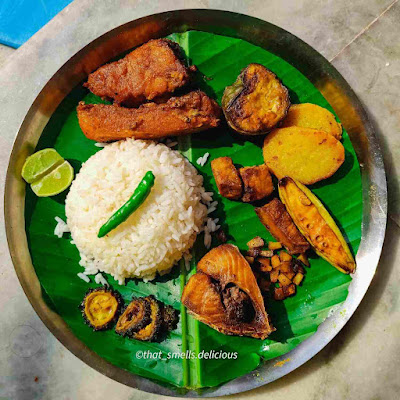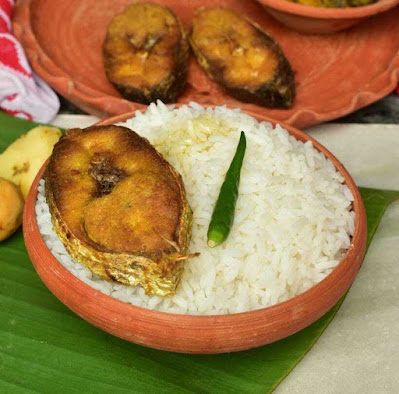 |
| Rice served with fried vegetables, Hilsa and Rohu fishes (Credits: Debasmita Das |
Ranna Pujo or a cooking festival is usually observed on the day of Vishwakarma Puja. It is celebrated widely across West Bengal, especially in the villages. This year ‘ranna’ puja is scheduled for 17th and 18th September.
As the tradition follows, the household is prepared for the festival by cleaning the house and washing all the washable items like bedsheets, utensils and so on. The floors of the house are also scrubbed and cleaned.
In this festival, the ‘Oshtonag’ or the goddess of snakes is worshipped. However, there’s a scientific logic to this festival which is quite interesting. During the monsoon season, the villages get over-flooded and there are instances when the snakes are found taking shelter in the household. As the stoves are generally made of mud, those are the ideal places for snakes and rats to hide. During the ‘ranna’ puja, the whole household is cleaned including the kitchen to ensure the house is free from any insects and snakes. Also, cleaning up the household thoroughly ensures that hygiene is maintained.
The ritualistic ‘ranna’ puja in villages
Before ‘ranna’ puja, every utensil in the kitchen is removed and the place is cleaned thoroughly. On the day of the puja, after taking bath, women of the house prepare a new stove of mud. They are supposed to cook on this new stove from then onwards. New utensils are also bought during the ‘ranna’ puja. A special spatula is used during the puja for cooking. It is generally a branch of a date palm tree.
After the stove is made, preparations start elaborately for the cooking of the dishes. The preparations continue during the day, the main cooking begins during the night. The women of the household cook throughout the night.
The Snake Goddess is worshipped the next day. The ‘bhog’ is served to the ‘Oshtonag’ in seven leaves of Shapla flower. Manasha tree’s branch is used as the Oshtonag deity. Around the deity, seven leaves are surrounded. On each plate, ‘bhog’ is served that was cooked in the last night. A new ‘diya’ is lit and incense sticks are burnt. After the arrangement, the ‘pujari’ starts the puja and all the members of the household offer prayers to the divine. After the puja, guests are invited for the meal.
 |
| Rice served with fried vegetables, Hilsa and Rohu fishes (Credits: Debasmita Das |
The meal is eaten cold and consists of the following items:
- Rice- Boiled rice is soaked in water overnight, which is known as Panta Bhaat is served with a slice of Gandharaj lemon.
- Vegetable curry- A mixed vegetable curry is prepared with gram seeds, coconut and taro root leaves or known as "kochu pata."
- Fries- Generally five types of vegetables are fried. These include potato, brinjal, coconut, pumpkin, coconut, banana, snake gourd fry and so on.
- Dal- A simple yellow dal is served with rice.
- Fish- Hilsa fry and Rohu Curry are the mandatory items in this festival.
- Chutney- Chalta or elephant apple is prepared into a sweet and sour chutney for the perfect finish to the meal. Some even put prawns in the chutney.
This ritual gets carried on for generations.
As the ancient people say, ‘Ranna’ Puja is observed and the Oshtonag is worshipped because the snake goddess will be pleased and cause no harm to them if the puja is concluded well
Author:
Rupa Jana

Post a Comment